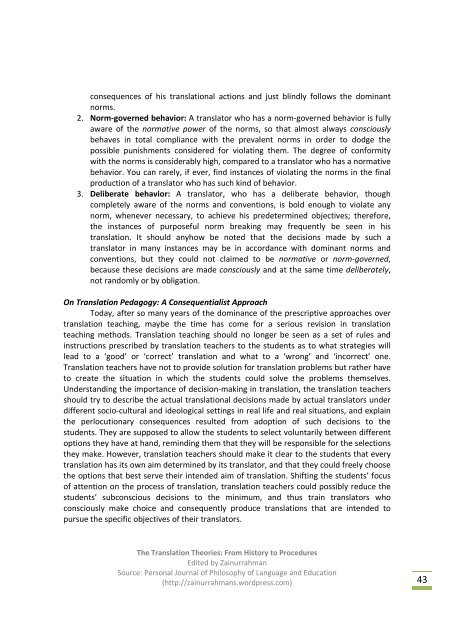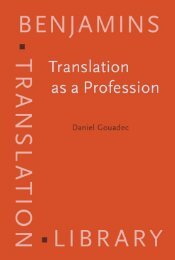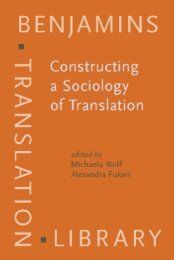Translation Theories.pdf
Translation Theories.pdf
Translation Theories.pdf
Create successful ePaper yourself
Turn your PDF publications into a flip-book with our unique Google optimized e-Paper software.
consequences of his translational actions and just blindly follows the dominant<br />
norms.<br />
2. Norm-governed behavior: A translator who has a norm-governed behavior is fully<br />
aware of the normative power of the norms, so that almost always consciously<br />
behaves in total compliance with the prevalent norms in order to dodge the<br />
possible punishments considered for violating them. The degree of conformity<br />
with the norms is considerably high, compared to a translator who has a normative<br />
behavior. You can rarely, if ever, find instances of violating the norms in the final<br />
production of a translator who has such kind of behavior.<br />
3. Deliberate behavior: A translator, who has a deliberate behavior, though<br />
completely aware of the norms and conventions, is bold enough to violate any<br />
norm, whenever necessary, to achieve his predetermined objectives; therefore,<br />
the instances of purposeful norm breaking may frequently be seen in his<br />
translation. It should anyhow be noted that the decisions made by such a<br />
translator in many instances may be in accordance with dominant norms and<br />
conventions, but they could not claimed to be normative or norm-governed,<br />
because these decisions are made consciously and at the same time deliberately,<br />
not randomly or by obligation.<br />
On <strong>Translation</strong> Pedagogy: A Consequentialist Approach<br />
Today, after so many years of the dominance of the prescriptive approaches over<br />
translation teaching, maybe the time has come for a serious revision in translation<br />
teaching methods. <strong>Translation</strong> teaching should no longer be seen as a set of rules and<br />
instructions prescribed by translation teachers to the students as to what strategies will<br />
lead to a ‘good’ or ‘correct’ translation and what to a ‘wrong’ and ‘incorrect’ one.<br />
<strong>Translation</strong> teachers have not to provide solution for translation problems but rather have<br />
to create the situation in which the students could solve the problems themselves.<br />
Understanding the importance of decision-making in translation, the translation teachers<br />
should try to describe the actual translational decisions made by actual translators under<br />
different socio-cultural and ideological settings in real life and real situations, and explain<br />
the perlocutionary consequences resulted from adoption of such decisions to the<br />
students. They are supposed to allow the students to select voluntarily between different<br />
options they have at hand, reminding them that they will be responsible for the selections<br />
they make. However, translation teachers should make it clear to the students that every<br />
translation has its own aim determined by its translator, and that they could freely choose<br />
the options that best serve their intended aim of translation. Shifting the students’ focus<br />
of attention on the process of translation, translation teachers could possibly reduce the<br />
students’ subconscious decisions to the minimum, and thus train translators who<br />
consciously make choice and consequently produce translations that are intended to<br />
pursue the specific objectives of their translators.<br />
The <strong>Translation</strong> <strong>Theories</strong>: From History to Procedures<br />
Edited by Zainurrahman<br />
Source: Personal Journal of Philosophy of Language and Education<br />
(http://zainurrahmans.wordpress.com) 43

















